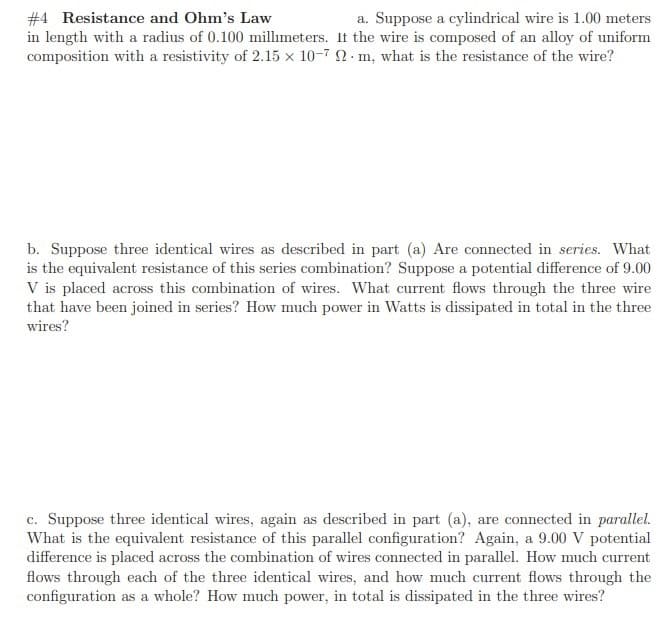#4 Resistance and Ohm's Law in length with a radius of 0.100 millmeters. It the wire is composed of an alloy of uniform composition with a resistivity of 2.15 x 10-7 . m, what is the resistance of the wire? a. Suppose a cylindrical wire is 1.00 meters b. Suppose three identical wires as described in part (a) Are connected in series. What is the equivalent resistance of this series combination? Suppose a potential difference of 9.00 V is placed across this combination of wires. What current flows through the three wire that have been joined in series? How much power in Watts is dissipated in total in the three wires? c. Suppose three identical wires, again as described in part (a), are connected in parallel. What is the equivalent resistance of this parallel configuration? Again, a 9.00 V potential difference is placed across the combination of wires connected in parallel. How much current flows through each of the three identical wires, and how much current flows through the configuration as a whole? How much power, in total is dissipated in the three wires?
#4 Resistance and Ohm's Law in length with a radius of 0.100 millmeters. It the wire is composed of an alloy of uniform composition with a resistivity of 2.15 x 10-7 . m, what is the resistance of the wire? a. Suppose a cylindrical wire is 1.00 meters b. Suppose three identical wires as described in part (a) Are connected in series. What is the equivalent resistance of this series combination? Suppose a potential difference of 9.00 V is placed across this combination of wires. What current flows through the three wire that have been joined in series? How much power in Watts is dissipated in total in the three wires? c. Suppose three identical wires, again as described in part (a), are connected in parallel. What is the equivalent resistance of this parallel configuration? Again, a 9.00 V potential difference is placed across the combination of wires connected in parallel. How much current flows through each of the three identical wires, and how much current flows through the configuration as a whole? How much power, in total is dissipated in the three wires?
Delmar's Standard Textbook Of Electricity
7th Edition
ISBN:9781337900348
Author:Stephen L. Herman
Publisher:Stephen L. Herman
Chapter29: Dc Generators
Section: Chapter Questions
Problem 1PA: You are working as an electrician in a large steel manufacturing plant, and you are in the process...
Related questions
Question
image

Transcribed Image Text:#4 Resistance and Ohm's Law
in length with a radius of 0.100 millmeters. It the wire is composed of an alloy of uniform
composition with a resistivity of 2.15 x 10-7 . m, what is the resistance of the wire?
a. Suppose a cylindrical wire is 1.00 meters
b. Suppose three identical wires as described in part (a) Are connected in series. What
is the equivalent resistance of this series combination? Suppose a potential difference of 9.00
V is placed across this combination of wires. What current flows through the three wire
that have been joined in series? How much power in Watts is dissipated in total in the three
wires?
c. Suppose three identical wires, again as described in part (a), are connected in parallel.
What is the equivalent resistance of this parallel configuration? Again, a 9.00 V potential
difference is placed across the combination of wires connected in parallel. How much current
flows through each of the three identical wires, and how much current flows through the
configuration as a whole? How much power, in total is dissipated in the three wires?
Expert Solution
This question has been solved!
Explore an expertly crafted, step-by-step solution for a thorough understanding of key concepts.
Step by step
Solved in 2 steps with 2 images

Knowledge Booster
Learn more about
Need a deep-dive on the concept behind this application? Look no further. Learn more about this topic, electrical-engineering and related others by exploring similar questions and additional content below.Recommended textbooks for you

Delmar's Standard Textbook Of Electricity
Electrical Engineering
ISBN:
9781337900348
Author:
Stephen L. Herman
Publisher:
Cengage Learning

Delmar's Standard Textbook Of Electricity
Electrical Engineering
ISBN:
9781337900348
Author:
Stephen L. Herman
Publisher:
Cengage Learning